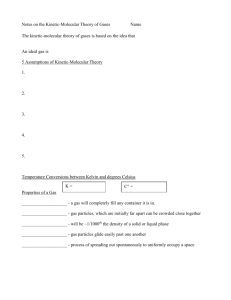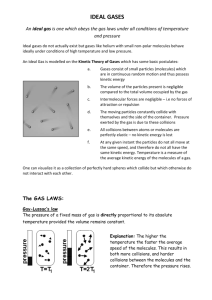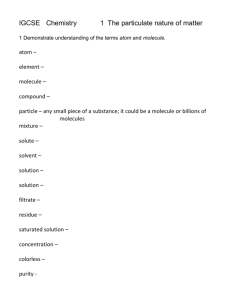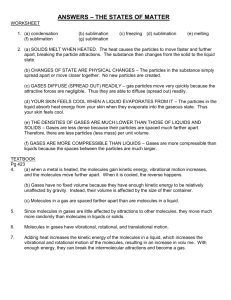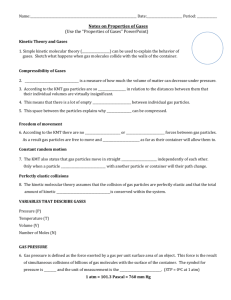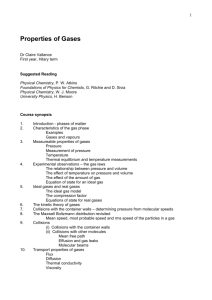Chapter VII
advertisement
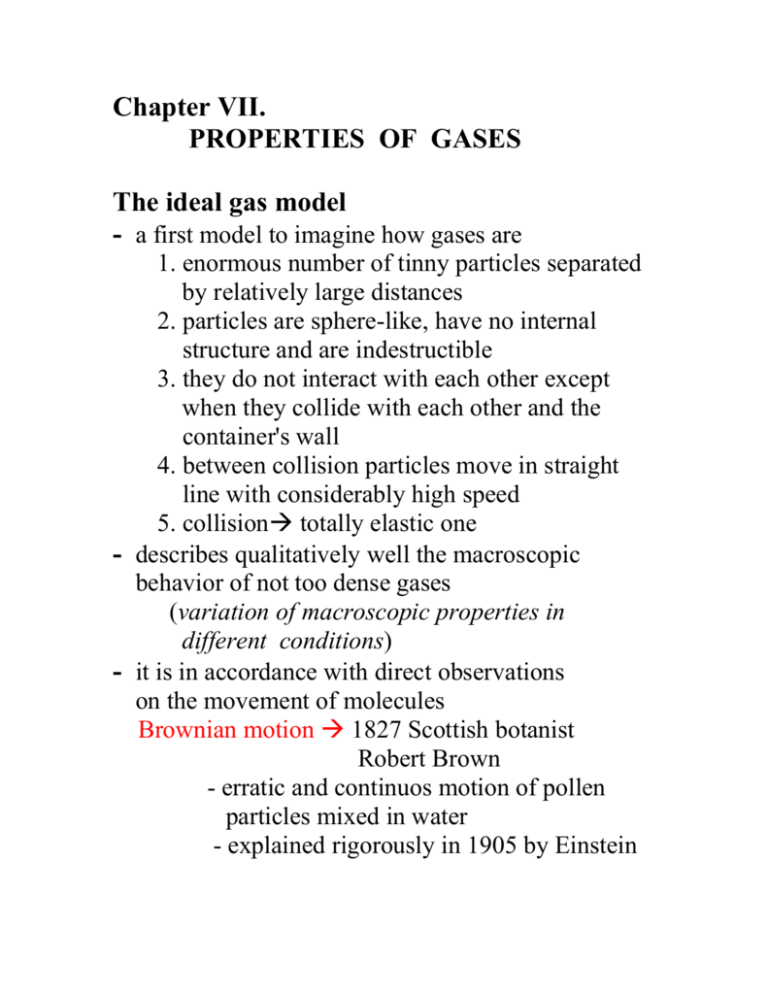
Chapter VII. PROPERTIES OF GASES The ideal gas model - a first model to imagine how gases are 1. enormous number of tinny particles separated by relatively large distances 2. particles are sphere-like, have no internal structure and are indestructible 3. they do not interact with each other except when they collide with each other and the container's wall 4. between collision particles move in straight line with considerably high speed 5. collision totally elastic one - describes qualitatively well the macroscopic behavior of not too dense gases (variation of macroscopic properties in different conditions) - it is in accordance with direct observations on the movement of molecules Brownian motion 1827 Scottish botanist Robert Brown - erratic and continuos motion of pollen particles mixed in water - explained rigorously in 1905 by Einstein Macroscopic parameters of the ideal gases 1. volume (V) (units in SI 1 m3) 2. mass (M) 3. pressure (P) it is a result of the atomic motion Pressure is the force exerted perpendicularly on a surface divided by the area of the surface. (Force per unit area)-scalar quantity !!! F ; units in SI: 1 N/m2 , called Pa (Pascal) A - due to the continuos collision of molecules with the wall of container the molecules act with a force on the wall the wall experience the pressure of the gas - shrinking the volume of the container more frequent collision increase in the P - increasing the number of particles more frequent collision increase in P - increasing the temperaturemovement of molecules with bigger speed increase in P 4. temperature (T) - usually defined asour feelings of hot and cold - subjective feelings of hot and cold are not accurate - accurately assign numbers to temperatures done by thermometers P -first thermometer Galileo -replaced by the alcohol-in-glass thermometer -nowadays bimetals, semiconductor sensors, thermocouples etc… The main problem standardizing the scales !!! (temperature values be reproducible) we need two reproducible temperatures and divide the interval between them in equal divisions first scale proposed by Newton (1701) I. temperaturea mixture of ice + water II. temperature human body temperature interval divided in 12 equal divisions Gabriel Fahrenheit propose for the II. temperaturebiling point of pure water I. temp.=32 0 F; II. temp.=212 0 F Fahrenheit temperature scale a new scale in 1948 I. temp.=0 0 C; II. temp.=100 0 C Celsius temperature scale for SI a new scale defined by the properties of ideal gases, distance between units is kept I. temperature the lowest possible temperature where the volume of ideal gases would go to zero 0 0 K=-273 0 C II. temperature where water freezes 273 0 K=0 0 C Kelvin temperature scale or absolute temperature scale Microscopic parameters of ideal gases 1. mass of one molecule (m) 2. number of molecules (N) 3. speed of a given molecule (v) - different molecules might have different speed - the value of speed is changing in time - experiment to study the speed distribution of particles rotating drum experiment Result: - most of the particles have speed near the average speed, - average speed quite high value (500m/s) - few particles with low and high speed - speed increases as the temperature increases (the mean velocity at the square is proportional with the temperature): v ~ T 4. kinetic energy of molecules (Ek) E ~ T 5.momentum of molecules ( p ) 2 k The Ideal Gas Law The three macroscopic properties of a given gas: volume, temperature and pressure-are related by a relationship known as the ideal gas law. This law states: PV cT P the pressure; Vvolume; Tabsolute thermodynamic temperature c a constant which depends on the amount of gas The ideal gas law is a combination of three experimentally discovered relationships! I. For a given ideal gas held at constant temperature the product of pressure and volume is a constant 1 if T=const PV=const P ~ V II. For a given ideal gas held at constant volume the pressure is linearly proportional with the absolute thermodynamic temperature if V=const P~T III. For a given ideal gas at constant pressure the volume is linearly proportional with the absolute thermodynamic temperature if P=constV~T Home-work assignments: 181/24-28, 181/30-33, 181/37-42, 182/51-54 183/17-20, 183/23-24
